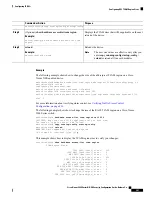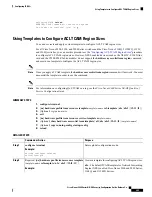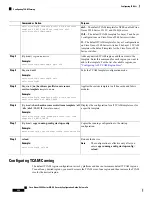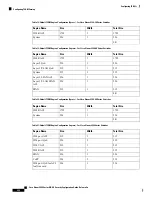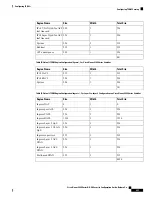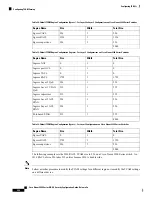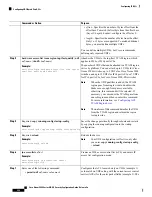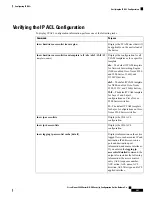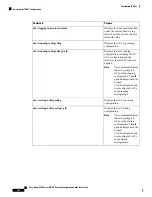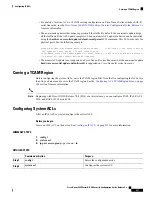
The default redirect TCAM region size of 256 might not be sufficient if you are running many BFD or DHCP
relay sessions. To accommodate more BFD or DHCP relay sessions, you might need to increase the TCAM
size to 512 or greater.
Note
Related Topics
Configuring ACL TCAM Region Sizes
, on page 240
Configuring UDF-Based Port ACLs
You can configure UDF-based port ACLs for Cisco Nexus 9200, 9300, and 9300-EX Series switches. This
feature enables the device to match on user-defined fields (UDFs) and to apply the matching packets to an
IPv4 port ACL.
You can configure UDF-based port IPv6 ACLs for Cisco Nexus 9300-EX switches. This feature enables the
device to match on the new UDFs and to apply the matching packets to an IPv6 port ACL.
SUMMARY STEPS
1.
configure terminal
2.
udf udf-name offset-base offset length
3.
hardware access-list tcam region ing-ifacl qualify
{
udf udf-name
|
v6udf v6udf-name
}
4.
copy running-config startup-config
5.
reload
6.
ip access-list udf-acl
7.
Enter one of the following commands:
•
permit udf udf-name value mask
•
permit ip source destination udf udf-name value mask
8.
(Optional)
copy running-config startup-config
DETAILED STEPS
Purpose
Command or Action
Enters global configuration mode.
configure terminal
Example:
Step 1
switch# configure terminal
switch(config)#
Defines the UDF as follows:
udf udf-name offset-base offset length
Step 2
Example:
•
udf-name
—Specifies the name of the UDF. You can
enter up to 16 alphanumeric characters for the name.
switch(config)# udf pktoff10 packet-start 10 2
•
offset-base
—Specifies the UDF offset base as follows,
where
header
is the packet header to consider for the
Example:
switch(config)# udf pktoff10 header outer l3 20 2
offset: {
packet-start
|
header
{
outer
|
inner
{
l3
|
l4
}}}.
Cisco Nexus 9000 Series NX-OS Security Configuration Guide, Release 9.x
257
Configuring IP ACLs
Configuring UDF-Based Port ACLs





